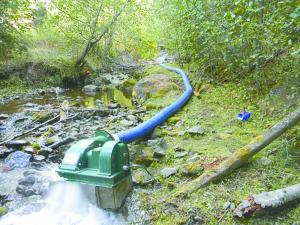2019 - Volume #43, Issue #1, Page #27
[ Sample Stories From This Issue | List of All Stories In This Issue | Print this story
| Read this issue]
Low-Drop Hydroelectric Generator
 |
After years of research and development, the retired mechanical engineer designed a low-head hydropower cross-flow turbine generator that consistently produces 1,500 watts of energy. That’s more than enough for most non-electrically heated homes which use about 1,000 watts continuously.
Low-head refers to how much the water drops before going through the turbine.
“I had a small creek without a lot of drop and tried other turbines on the market. With low volume and low head nothing would work,” Scott says. “This works like a squirrel cage made of stainless steel.”
Water, coming from a source about 20 ft. above the turbine, is directed through a 6-in. pipe with a screened inlet to keep out debris. The water shoots horizontally through the turbine and turns blades to power the permanent magnet 3-phase alternator of the generator. That power feeds directly into the utility grid or controls to charge batteries.
Scott began working on the turbine generator after moving to Republic, Wash., in a remote area near the Canadian border. With a $100,000 investment required to bring in electricity, he first tried solar power, which didn’t work well with too many cloudy, snowy days. With a creek nearby, hydropower made the most sense, and Scott has had his turbine installed for about a decade. He sells a basic turbine/generator to connect into a power grid for $3,900, or $5,800 with a grid tie inverter. Systems to charge batteries cost $5,250 and $7,900.
“I charge just one 24-volt battery,” Scott says, because he has continuous power and doesn’t need batteries for storage. He has enough electricity to power his house and shop.
The system runs year round since water continues to flow, even when the creek freezes over. One customer in Alaska runs a resort with the turbine. Other turbines have gone to Belize, Germany, Australia and developing countries.
“It works on any remote site with flowing water,” Scott says. Besides residential customers he knows of a water treatment plant that uses the turbine to power a remote office. A fish hatchery uses overflow water to power the hatchery.
Other than occasional greasing, the turbine is maintenance-free, Scott says. His has run for 10 years without any problems. He suggests building a structure over it to protect it from snow and rain.
“It’s amazing how simple but complex it can be,” he says, noting it took lots of trial and error to get the forms just right for a Spokane foundry to cast the turbines.
Contact Scott to find dealers in your area or order directly from him. Scott welcomes dealer inquiries.
Contact: FARM SHOW Followup, Scott Hydroelectric, P.O. Box 501, Republic, Wash. 99166 (ph 509 680-4804; www.scotthydroelectric.com; ScottHydroelectric@outlook.com).

Click here to download page story appeared in.

Click here to read entire issue
To read the rest of this story, download this issue below or click here to register with your account number.




